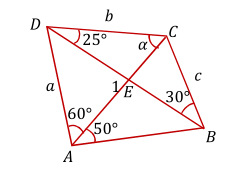Geometry Question by Mithil Shah # 4
Let
A
B
C
D
be a convex quadrilateral in which
∠
B
A
C
=
5
0
∘
,
∠
C
A
D
=
6
0
∘
,
∠
C
B
D
=
3
0
∘
and
∠
B
D
C
=
2
5
∘
. If
E
is the point of intersection of
A
C
and
B
D
, find
∠
A
E
B
.
The answer is 95.
This section requires Javascript.
You are seeing this because something didn't load right. We suggest you, (a) try
refreshing the page, (b) enabling javascript if it is disabled on your browser and,
finally, (c)
loading the
non-javascript version of this page
. We're sorry about the hassle.
3 solutions
Very nice. Would it also work for a different choice of angles, though. What if ∠ C B D = 3 2 ∘ instead of 3 0 ∘ ?
Log in to reply
Yes if the angles subtended by the line segment (side) on the two points (vertices) are the double or half of one another then it will always work.
Circumscribe a circle about triangle DCB. Since m<CAB = 2 m<CDB and m<CAD = 2 m<CBD, we know A is the center of this circle. Extend CA to intersect the circle at C', which is the diametrically opposite point to C. Thus, C'B is a 130 degree arc, and CD is a 60 degree arc, so the pink angle must be (130+60)/2= 95 degrees
As is often the case, the solution is much easier to guess than to calculate. Below is the calculation.

We can arbitrarily set A C = 1 and A D = a . From △ A C D using the law of cosines D C = b = a 2 − a + 1
In the same triangle with law of sines α = a r c s i n ( b a s i n ( 6 0 ∘ ) ) = a r c s i n ( 2 a 2 − a + 1 a 3 )
From △ B C D we know that ∠ B C D = 1 2 5 ∘ so ∠ B C A = 1 2 5 ∘ − α and in △ A B C the ∠ A B C = 1 8 0 ∘ − 5 0 ∘ − ( 1 2 5 ∘ − α ) = 5 ∘ + α .
From law of sines in △ A B C we get s i n ( 5 ∘ + α ) = c s i n ( 5 0 ∘ )
But c from △ B C D is s i n ( 2 5 ∘ ) c = s i n ( 3 0 ∘ ) b
Putting it together into a single equation for a we get
s i n ( 5 ∘ + a r c s i n ( 2 a 2 − a + 1 a 3 ) ) = s i n ( 2 5 ∘ ) s i n ( 5 0 ∘ ) a 2 − a + 1 s i n ( 3 0 ∘ )
The solution of this equation is a = 1 , so the △ A C D is equilateral and α = 6 0 ∘
From △ C D E the ∠ C E D = 1 8 0 ∘ − 6 0 ∘ − 2 5 ∘ = 9 5 ∘ , which means ∠ A E B = 9 5 ∘ .
Nice trig Bash. "And as is often the case, the geometric solution is much more interesting than trigonometric one."
Let ∠ A D B = x ∘ Then ∠ A B D = 1 8 0 ∘ − 1 1 0 ∘ − x ∘ = ( 7 0 − x ) ∘ Clearly, Quadrilateral A B F D is a c y c l i c quadrilateral . => ∠ B A D = ∠ B D F = 5 0 d e g r e e s = > ∠ C D F = 2 5 ∘ , ∠ A D B = ∠ A F B = x ∘ and ∠ A B D = ∠ A F D = ( 7 0 − x ) ∘ .
Now have a look at the configurations in the a b o v e diagram, B C and D C are the angle bisectors of ∠ D B F , ∠ B D F respectively in Δ F B D . => C is the incenter. => F C is the angle bisector of ∠ D F B . = x ∘ = ( 7 0 − x ) ∘ => x ∘ = 3 5 ∘ . Now ∠ A E B = ∠ A F B + ∠ D B F = x ∘ + 6 0 ∘ = 3 5 ∘ + 6 0 ∘ = 9 5 ∘
K . I . P . K . I . G .